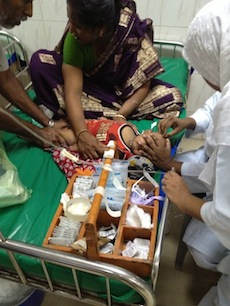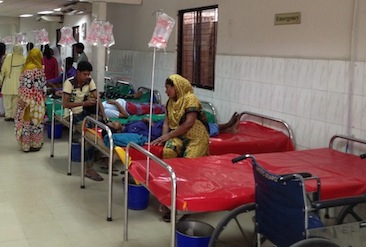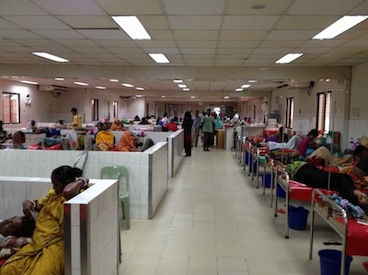A young woman with flowing orange pants, a long red tunic, and a beautifully patterned but tattered shawl slowly picks her way across the crowded intersection, a small child clutched tightly in her arms. She appears almost oblivious to the mass of honking cars, roaring trucks, tiny three-wheeled green taxis, and lumbering rickshaws and handcarts swarming all around her, yet somehow makes it unscathed across the road. I watch as she passes through the glass doors of the hospital and walks the last few steps to the triage desk, where I am sitting with one of the more experienced nurses. The mother quickly unwraps her child and presents him to us. The child is small, maybe eight or nine months, and lies quietly, unmoving in his mothers arms, mouth slightly open, eyes staring off into space. The diarrhea started two days ago, the mother explains to the nurse in Bangla, but this morning he became limp and cool and stopped feeding. The triage nurse, moving more rapidly than I've ever seen a healthcare worker move in the developing world, glances at the child's dry tongue, pinches the skin of his belly, feels for the pulse in his small wrist -- all various signs of dehydration -- and then calls for another nurse, who rapidly places an intravenous line and begins rehydration.
Just seconds later a rickshaw pulls up in front of the hospital with two young men supporting their elderly mother between them. Together, they carry her up to the triage desk. "Diarrhea since the morning," the older son states in a worried voice. With a call from the triage nurse, an orderly runs over with a wheelchair, quickly moving the old woman over to a green cot with a hole in the middle and a bucket underneath it (for catching stool) and starts intravenous fluids. A minute later a young man walks up unsteadily to the triage desk, looking as though he is about to pass out. And then two worried parents, holding a pair of twins in their arms, pushes forward. And then a family carrying in a limp woman in a black burka. And then another, and another, and still another, all day long and all through the night, without end.

This is the Dhaka Hospital of the International Center for Diarrheal Disease Research, Bangladesh (icddr,b). But throughout the city and surrounding districts from which patients come, it is known simply as "Cholera Hospital." Say those two words to any rickshaw driver in town and, though they may not speak any English, they will always know exactly what you mean. Not all of the patients who come here have cholera, but about a quarter do, depending on the season and the age of the patient. As a result, Dhaka Hospital, which has been in existence for 40 years, has more experience managing cholera and other diarrheal disease than any other hospital in the world, typically seeing hundreds of patients a day and hundreds of thousands each year.

Though not as sexy as other global diseases like HIV or malaria that more often grab headlines and generate research and aid funding, diarrhea is still one of the most serious causes of death and disability worldwide. Despite significant improvements in prevention and treatment efforts over the past few decades, it remains the second biggest killer of children in the world after pneumonia, resulting in nearly three quarters of a million child deaths each year. A recent series of articles published in The Lancet, a renowned international medical journal, finds that while we may not be able to ever get rid of diarrhea itself (though new vaccinations have the potential for decreasing it significantly), deaths from diarrhea can be almost entirely prevented. The vast majority of cases in children, for instance, can be treated with simple oral rehydration solution (essentially a mix of water, sugar and salt) and zinc tablets. Even in cases of severe diarrhea from cholera, rapid rehydration with intravenous saline and a single dose of a cheap antibiotic almost entirely prevents death in both children and adults. The key lies in developing new protocols that maximize the effectiveness and efficiency of these simple treatments and then creating health systems and training health workers in the many hard-to-reach corners of the world to implement these protocols.

This is exactly what the physicians and scientists at icddr,b have been doing for decades. They were among the creators of ORS and conducted some of the earliest research on childhood diarrhea. Now I am working with physicians here on a new project to improve the efficiency and effectiveness of rehydration therapy by finding better ways of separating out the small number of patients with severe dehydration, who require intravenous fluids, from the vast majority, who can be treated with oral rehydration alone. If the study is successful, we hope to use the results to develop new protocols that front-line health workers can use to manage diarrhea in poor countries worldwide. The world has made incredible progress in reducing deaths from childhood diarrhea over the past several decades. With continued and sustained effort, we can hopefully bring the annual diarrhea death count down to zero in the coming decades.
Adam Levine is an Assistant Professor of Emergency Medicine and Co-Director of the Global Emergency Medicine Fellowship at Brown University. He currently serves as the Clinical Advisor for Emergency and Trauma Care for Partners In Health-Rwanda and as a member of the Emergency Response Team for International Medical Corps. His research focuses on improving the delivery of acute care in low-income countries and during humanitarian emergencies. The views expressed in this blog are his alone and do not necessarily represent the views of any of the organizations mentioned above.
(1)
(2)
(3)
